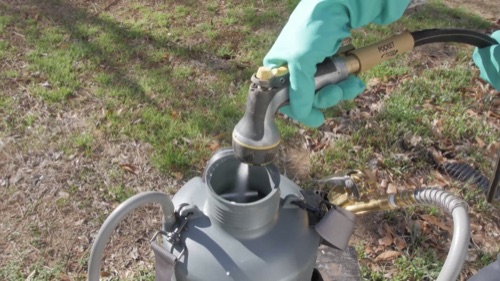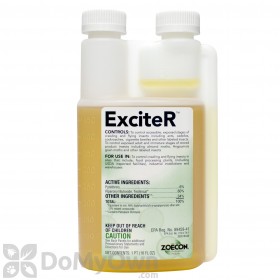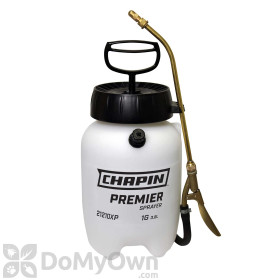
Millipedes are unobtrusive pests that do not bite or sting and generally cannot survive indoors, but can cause an allergic reaction upon contact with the sticky substance they release when distressed.
In small numbers, millipedes can be beneficial as they breakdown rotting material quickly. But too many millipedes in your lawn, or millipedes inside your home or structure, should be treated.
Read this guide on millipede control to learn how to get rid of millipedes, both outside and inside.
Use a Liquid Insecticide
An insecticide treatment around your home will control an active millipede infestation.
Select and Mix Your Liquid Insecticide

Begin by selecting an insecticide labeled for millipede control, like Suspend Polyzone or Talstar P.
Read the label of the insecticide to be sure the product can be used safely around the outside of your home or structure and in cracks and crevices indoors.
Next, grab the spraying equipment of your choice, such as a hand pump sprayer. Read the label of your insecticide to determine how much product you will need and how much water you will need to cover the perimeter of your structure.
Then, while wearing protective gloves and long sleeves, add half the water needed to your sprayer. Add the amount of insecticide you will need, then the remaining amount of water. Add the cap to your sprayer and shake to thoroughly mix your water and product.
Pro Tip
If you have a large infestation of millipedes and want to get rid of them quick, add ExciteR Insecticide to your primary insecticide and water mixture. ExciteR targets millipedes quickly while the primary insecticide selected in Step 1A prevents new millipedes from infesting the building.
Read the label of ExciteR to see if it is compatible with the primary insecticide of your choice. When used alone, ExciteR will only work on existing millipedes and will not repel new millipedes away.
Products needed for Step 1A
Spray Your Insecticide Treatment

Walk the perimeter of your home or structure and spray the following areas with your insecticide-water solution:
- 3 feet up and 3 feet out around the foundation of the structure
- Around door and window frames
- In cracks and crevices around the perimeter of the home
- Around where cables, pipes, and wires enter the structure
- Around vents and soffits
Repeat this treatment every 30-60 days as needed. Consult the label of your insecticide for instructions on how often to reapply.
Millipedes generally do not survive inside the home unless they are in a very damp area. But if you do have a millipede infestation, you can spot treat that area with an insecticide labeled for millipedes.
In infested rooms or crawl spaces, spray the following areas:
- The corners of the room
- Where the baseboard meets the floor
- In cracks and crevices
- Around door and window frames
You can also directly spray any living millipedes that you see. Do not broadcast spray the floor or walls of the room. Instead, focus on cracks, crevices, and voids.
Use an Insecticide Dust
Insecticide dusts are long-lasting and are great for hard to reach areas like cracks, crevices, and wall voids. Because dusts are a slow kill, we recommend using them in addition to insecticide spray treatments.
Select and Apply the Dust
When choosing an insecticide dust, remember to choose a dust that can be used in moist areas, as that is where millipedes are often found. An insecticide dust like Delta Dust is great for wet and damp areas. Read the label of the insecticide dust to ensure the dust is labeled for millipedes and can be used indoors and outdoors. Outdoor dusts may need to be reapplied after rain or snow.
Fill a bellow hand duster half-way with the dust of your choice. Secure the lid of the duster back on and turn the duster upside down so that the lid is pointing to the floor. Then, dust 1-2 puffs at a time in each of the following areas around your home:
- Where baseboards meet floors
- In wall voids behind electrical outlets
- Beneath sinks where pipes meet the wall or floor
- Behind toilets or sinks where plumbing pipes meet the wall
- Around door and window frames (indoors and outside)
- On the base of rock or stone walls and in between lumber in railroad-tie walls
- In holes where wasps or carpenter bees are boring into wood
- In the corners of garages
- In eaves and soffits
- Under stairways
- Where utility pipes enter the home
- Around the foundation of the home
- In cracks and crevices around the home
Do not apply too much dust at once. A light dusting will be plenty! Reapply as needed.
Products needed for Step 2A
Use a Granular Insecticide Outdoors
Select and Apply Your Granular Insecticide
Choose a granular insecticide labeled for millipedes, such as Talstar PL Granules or Talstar XTRA Granules.
Using a broadcast spreader or handheld spreader, apply the granular insecticide of your choice to your lawn.
- Walk up and down your lawn in rows, slowly applying the granules.
- If using a broadcast spreader, make sure the granules "throwback" to the tire marks of the previous row for an even coverage.
- Once your lawn and garden are covered in the granules, you may need to water them in to activate. Read the label of your granular insecticide for instructions on when or if to water.
- Be sure to check the label of the granular insecticide to see if the insecticide can be used on your plants. Most granular insecticides cannot be used on edibles (fruits and vegetables) but can be used on ornamentals (flowers and shrubs).
Watch the video below for further instructions on how to use a granular spreader.
Products needed for Step 3A
Remove Moisture from the Home and Lawn

Millipedes are attracted to and thrive in moist areas. Removing damp areas from your home and lawn will ensure millipedes do not return after treatment. Read our how to prevent a millipede infestation guide for advice on how to eliminate moisture to keep millipedes away for good.
Once you have successfully controlled the millipede infestation in and around your home, you can take steps to prevent millipedes from returning. Click the right arrow below to learn about millipede prevention.


















